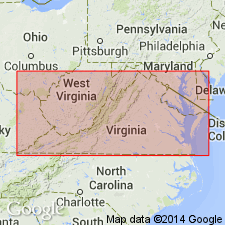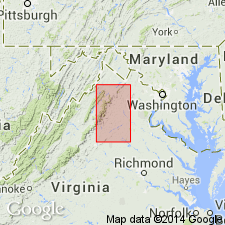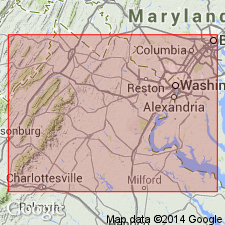
- Usage in publication:
-
- Cobbler Mountain Alkali Feldspar Quartz Syenite
- Modifications:
-
- First used
- Dominant lithology:
-
- Syenite
- AAPG geologic province:
-
- Piedmont-Blue Ridge province
Summary:
Tollo and Arav (in press) propose that Robertson River Formation of Allen (1963) be revised as Robertson River Igneous Suite to emphasize the lithologic diversity that characterizes this belt. Rocks range in composition from alkali syenite to alkali feldspar granite to granite. This suite is the largest group of intrusives within the Blue Ridge province of VA. Extends from near Upperville, 70 mi southwest to northern suburbs of Charlottesville. Includes at least nine mappable lithologic units, among them, Cobbler Mountain Alkali Feldspar Quartz Syenite (Arav, 1989: George Washington Univ. M.S. thesis). Unit is exposed throughout broad area in the northern segment of the Robertson River outcrop belt. In contact with several types of Grenville-age basement rocks and the Laurel Mills Granite (new name), which it intrudes.
Source: GNU records (USGS DDS-6; Reston GNULEX).

- Usage in publication:
-
- Cobbler Mountain Alkali Feldspar Quartz Syenite*
- Modifications:
-
- Named
- Dominant lithology:
-
- Syenite
- AAPG geologic province:
-
- Piedmont-Blue Ridge province
Summary:
Recent detailed mapping and petrologic analysis indicates rocks previously assigned to Robertson River Formation include a series of granitoids, syenitoids, and felsites emplaced sequentially during 30 m.y. episode of magmatism. Collectively, the rocks form a dike-like mass of intrusions extending nearly 100 km from vicinity of Charlottesville, VA to north-northwest of Ashby Gap, VA. Therefore, name is revised to Robertson River Igneous Suite. At least 8 units of the suite are distinguishable by mineral composition, texture, bulk chemical composition, and U-Pb-determined isotopic age, and can be mapped at 1:24,000 scale. Cobbler Mountain Alkali Feldspar Quartz Syenite is named for Little Cobbler Mountain. Type locality is roadcut north of Little Cobbler Mountain on north side of VA Hwy 55, 1.4 km (0.9 mi) west of intersection with US Hwy 17, Upperville 7.5-min quad, northern VA. Consists of dark-gray, medium-grained alkali feldspar quartz syenite typically displaying an interlocking network of abundant, subhedral to euhedral mesoperthite grains on weathered surfaces. Dikes of Cobbler Mountain rocks cut Laurel Mills Granite (new) west of Cobbler Mountain and intrude Middle Proterozoic basement gneiss located east of Robertson River outcrop belt along Goose Creek near Upperville. Age is Late Proterozoic. Report includes geologic map.
Source: GNU records (USGS DDS-6; Reston GNULEX).

- Usage in publication:
-
- Cobbler Mountain Alkali Feldspar Quartz Syenite*
- Modifications:
-
- Geochronologic dating
- AAPG geologic province:
-
- Piedmont-Blue Ridge province
Summary:
U-Pb age for Cobbler Mountain Alkali Feldspar Quartz Syenite is 722+/-3 Ma.
Source: GNU records (USGS DDS-6; Reston GNULEX).
For more information, please contact Nancy Stamm, Geologic Names Committee Secretary.
Asterisk (*) indicates published by U.S. Geological Survey authors.
"No current usage" (†) implies that a name has been abandoned or has fallen into disuse. Former usage and, if known, replacement name given in parentheses ( ).
Slash (/) indicates name conflicts with nomenclatural guidelines (CSN, 1933; ACSN, 1961, 1970; NACSN, 1983, 2005, 2021). May be explained within brackets ([ ]).

